Indoor lilies: features, types and cultivation
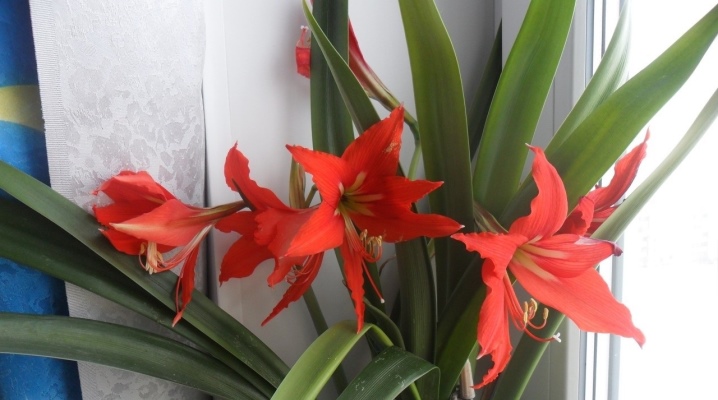
Perhaps one of the most beautiful indoor flowers are lilies. Many people acquire such adorable plants to decorate their home. However, before you get hold of indoor lilies, it is important to figure out how to properly care for them. Today we will take a closer look at these beautiful flowers and find out what subspecies they are divided into.
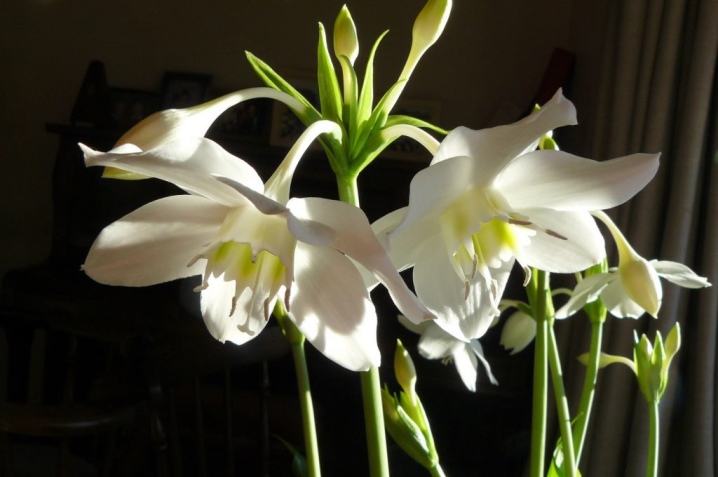
Description
There is no better interior decoration than fresh flowers. They are able to revive the atmosphere, fill it with colors. There are a great many types of indoor flowers that look really chic, expressive. Lily also belongs to such plants.
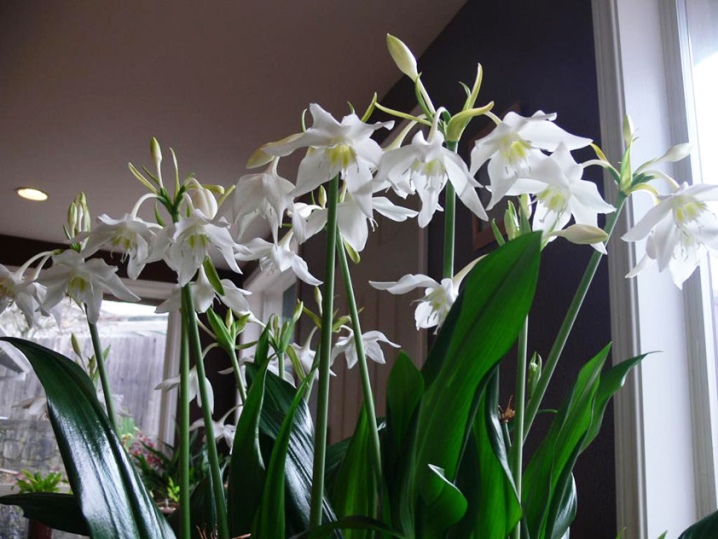
It is a very dainty bulbous flower with a wonderful, inviting scent that is popular with many people.
Lilies are perennials. Their bulbs consist of special, unclosed scales that are very juicy. Due to this feature, lilies are considered to be loose flowers. The size of the bulbs of a beautiful flower may be different. Their usual diameter ranges from 1 to 30 cm.
The bulbs have a characteristic spherical shape, but flowers with ovoid processes are also found. The scales are fixed on the bottom. This element represents the lower part of the bulb, where the growing point is located.
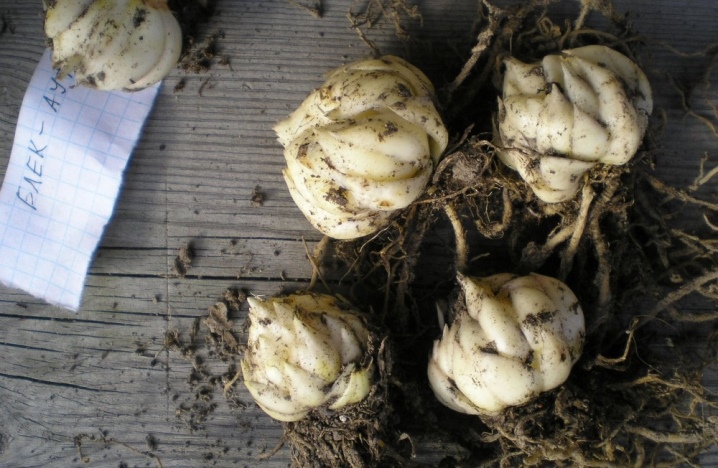
Lilies can have the following basic types of roots:
- basal and retractable are formed in the bottom area;
- supra-bulbous roots appear on the stem of the plant for only one season, after which they die off with it.
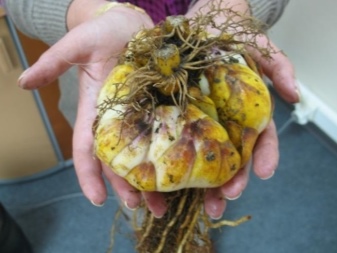
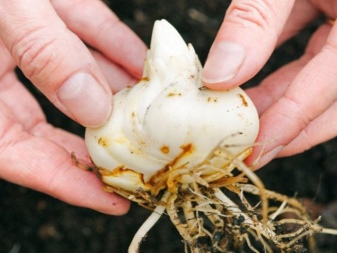
When transplanting lilies, it is extremely important to act carefully and carefully. It is necessary to take care of this flower in such a way as not to harm the root system. It is also impossible to overdry the plant in any case.
Lilies have a characteristic straight stem. Its height can be from 15 to 25 cm - this parameter directly depends on the specific type of flower. Along the entire length, the stem is covered with lily leaves, which sit firmly on it, as if curling up in a spiral.
There are subspecies of lilies that give a root rosette of leaves. In some cases, the foliage is collected on a stalk in a whorl type. There can be a different number of leaves on the basis of the lily. There are lush plants, well overgrown with leaf blades, and there are also more modest specimens with a small number of leaves.

The lily inflorescence forms a brush in the form of a cylinder, cone or umbrella. Usually the raceme bears about 8-16 flowers (the largest number rarely exceeds 30). Flowers in the inflorescence bloom in stages - from those at the bottom to those at the top. Each flower will keep without wilting for 3-9 days. Flowering usually lasts 2 weeks or more.
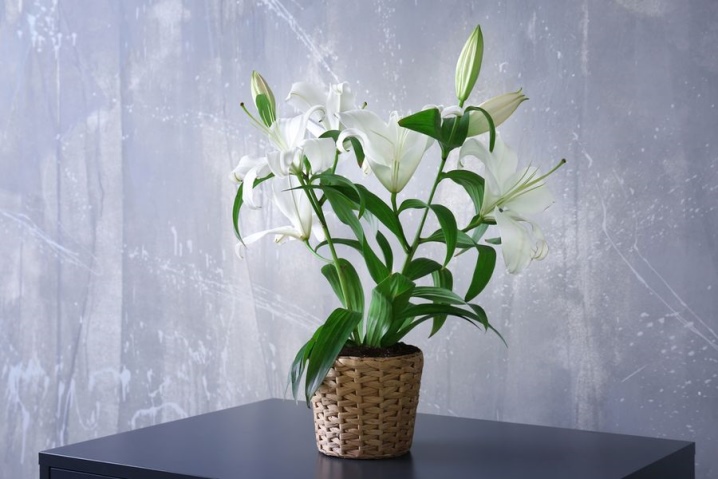
The flower of this popular plant itself consists of 6 separate petals arranged in two lines. In the center there are 6 stamens with large fluttering anthers, as well as a pistil, which looks more like a miniature pillar with a stigma crown. In most cases, the latter has a characteristic bright color, like anthers. The classic lily flower has only 6 petals, but there may be more of them, as is the case with beautiful terry varieties (tiger, curly).
The shape of the flowers can be:
- tubular;
- turban;
- funnel-shaped;
- bell-shaped;
- cupped;
- star-shaped;
- flat.
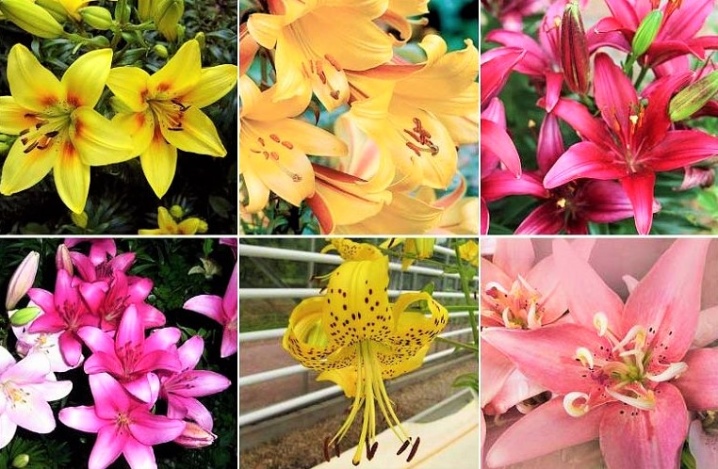
The color of flowers can be very different - from simple white to yellow, pink, etc. Plants can have specks, or they can bloom without them. One color can be seen in one flower, or a combination of several spectacular scales.
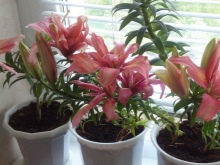
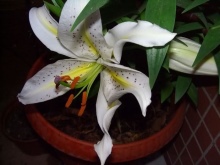
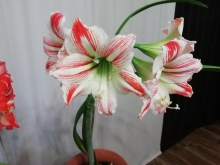
The size of the flowers of a home lily depends largely on its shape and structure. Slightly drooping turbid varieties in diameter can reach 5-10 cm. From the side, they look like miniature Chinese lanterns. Longer funnel-shaped flowers usually do not exceed the 4 cm mark in diameter, and their average length is about 15 cm.
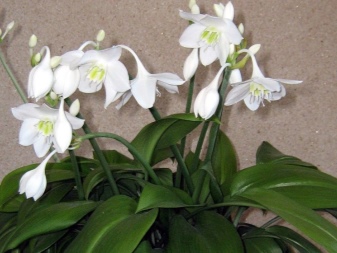
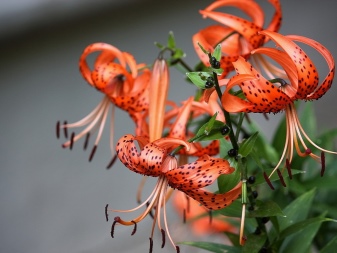
Lilies look really gorgeous in bouquets. They blend seamlessly with many other well-known colors.
Varieties
There are many varieties of house lilies that do great in pots. Each of the species has its own name, external distinctive characteristics. Let's get to know them better.
Asian
This is the name of pot lilies, which are one of the most unpretentious in matters of care and maintenance. It's easy to find a substrate for these beautiful flowers that they feel good in.

There are also no special requirements for the environment.
This species group includes many different varieties, differing from each other both in color and in the dates of flowering. The flowers of Asian varieties themselves are bowl-shaped or funnel-shaped. They are characterized by a staminate central part. Flowers usually grow up to 0.5-1.3 m in height.
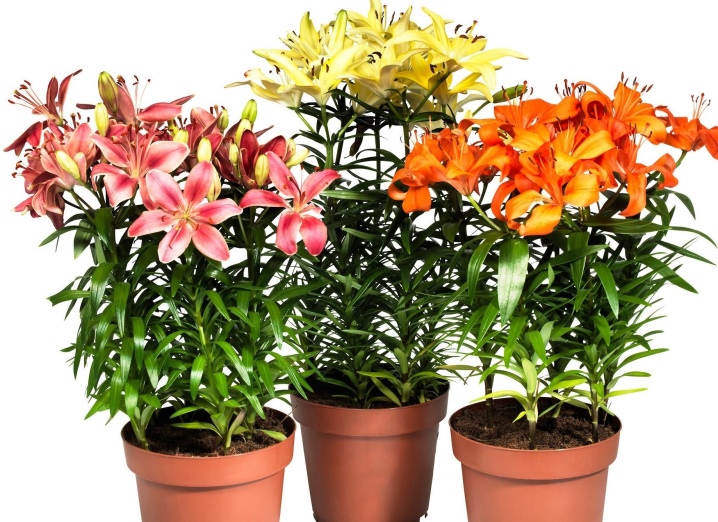
Oriental
This is the name of a rich group of lilies, distinguished by a special, exquisite beauty. Oriental flowers exude a pleasant, unobtrusive aroma. Their flowers are turbid or tubular.
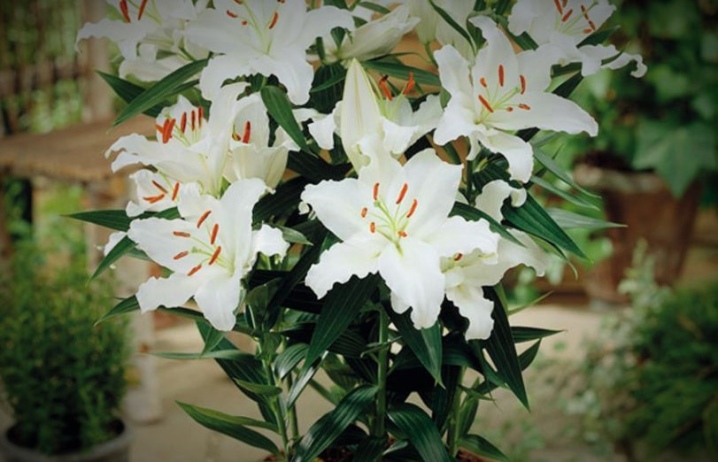
Flowers of this species are very beautiful, but capricious in matters of soil selection. Oriental lilies are susceptible to a number of serious viral diseases. For these flowers, it is recommended to prepare loose, acidic soil. It should be as nutritious as possible for the plant to take root properly.
Oriental lilies are more fond of when a lot of sunlight hits them. These flowers do not tolerate the effects of drafts.
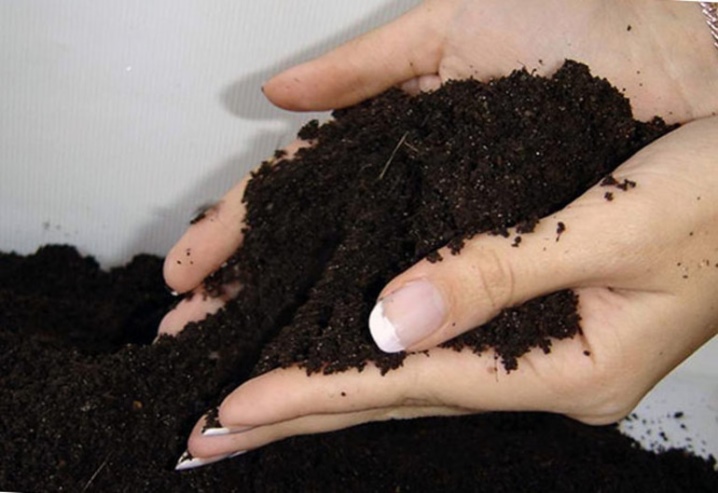
For home maintenance, they usually choose undersized varieties, the height of which does not exceed 50 cm. If we are talking about keeping in the garden, then it is permissible to plant larger specimens, the height of which can reach 2.5 m.
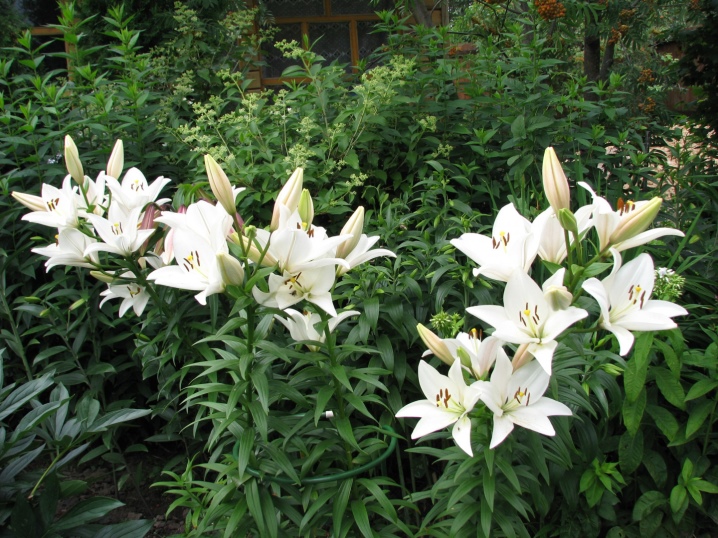
Curly
Hybrids that are not afraid of low temperatures. They can be grown both outdoors and at home. Curly lilies are extremely rare, which attracts many flower growers. Too acidic soil is not suitable for these flowers, so it is not recommended to use sawdust for mulching.
Curly lily species thrive best in dark environments. True, even being in the sun does not have a detrimental effect on them. These are perennial plants that may not change their location for many years. They bloom with drooping buds that bloom on long stems that stand upright. Their height varies from 1.1 to 1.7 m.
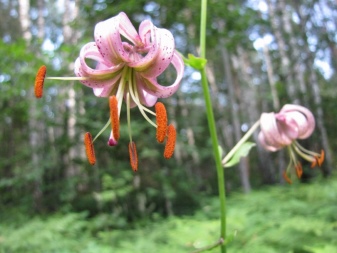
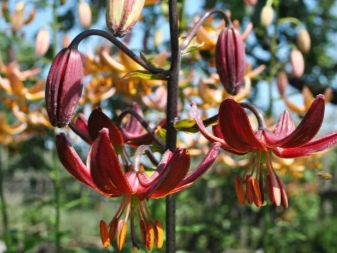
They need to be provided with a timely garter.
Golden
Perennial plant, bulbous plant. The usual rhizome diameter is 14 to 16 cm. Peduncles are arranged vertically. The height of the latter can be from 50 cm to 2 m.
The flowers are large and grow wide. They have elongated, curved petals characterized by fringed edging.
The main background of the flowers is white. It may have yellow longitudinal stripes in the center and black specks. A very delicate, delicate, but persistent aroma emanates from these lilies.
These spectacular plants bloom in August-September. They often suffer from fusarium. It is recommended to plant golden lilies in conditions of sufficient lighting, optimal humidity level.
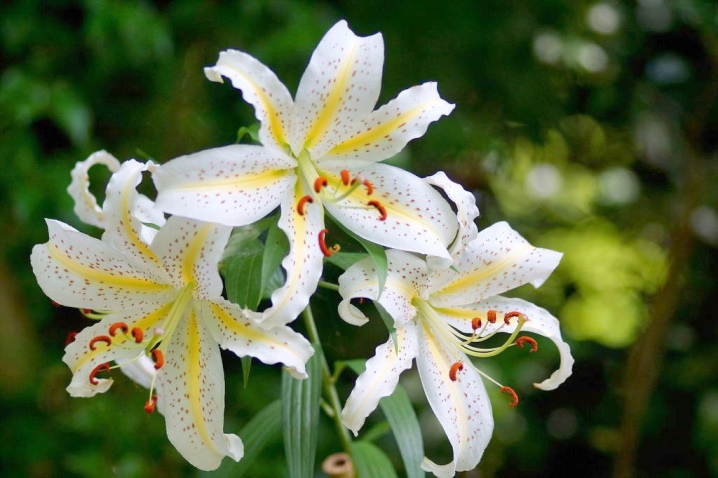
Royal
Tubular varieties of lilies, their average height is 1 m. The leaves of the flower are elongated, narrow. The average length is 9-13 cm.The flowers grow voluminous, tubular. The snow-white buds have a yellowish throat and a lush bunch on the stigma.

The petals of this plant have an even rounded shape. Usually, no more than 6 buds bloom on one peduncle. Varieties can retain their original qualities regardless of how they are propagated.

Royal lilies are undemanding in care, not capricious in maintenance.
Dwarf
Ideal for indoor cultivation conditions. They are small in size, and they are completely undemanding in care. These plants acquire a beautiful decorative appearance only for the flowering period, while the leaves do not have special attractiveness. Dwarf lilies are fast growing. They start flowering about a couple of weeks after planting.
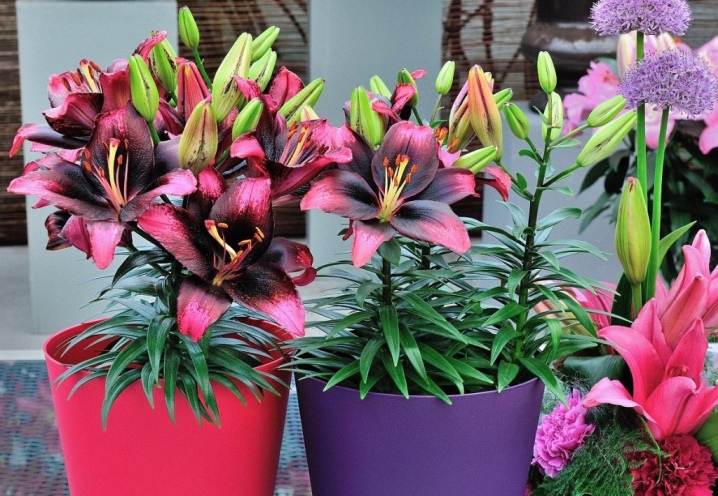
Longiflorum
These flowers are very popular with both beginners and more experienced florists. The relevance of long-flowered lilies is due to their incomparable beauty and stunning aroma. But for all their beauty and flashiness, these plants are among the most capricious. It is difficult to grow these types of lilies in garden conditions, but being on the windowsill, they bring much less trouble.
Long-flowered lily buds look like miniature bells with long and curved petals. The stem height can be up to 1 meter. In most cases, these flowers are grown for further cutting.
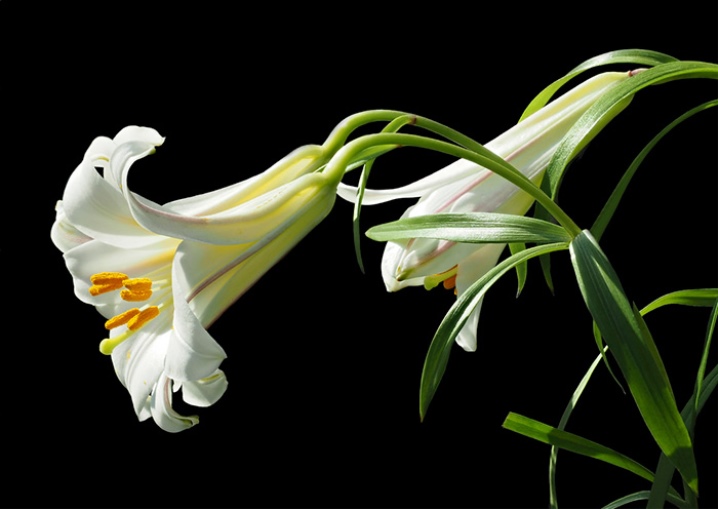
Hippeastrum
An interesting flower, which in its external characteristics is similar to another species - amaryllis. If you look closely, you can find many differences between these plants. The hippeastrum has a dense and strong stem, in the inner part of which there are no voids. The stem grows exceptionally straight.
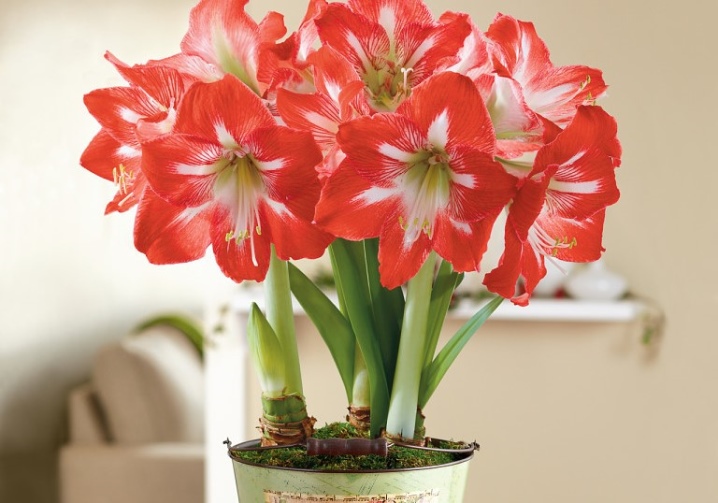
Hippeastrum blooms with multi-colored buds, distinguished by special beauty. The rhizome of the plant is bulbous, has a rounded or elongated structure, covered with whitish scales. The lion's share of representatives of the described species does not lose their green color at rest.
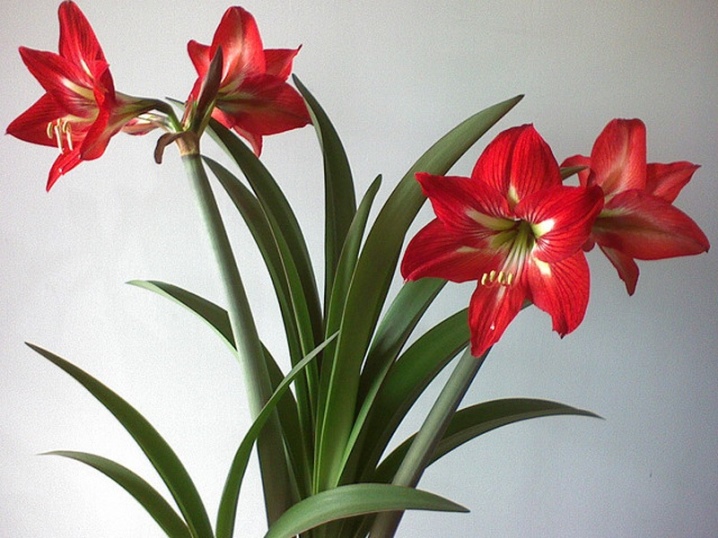
Amaryllis
Before going into a dormant state, this plant sheds leaves. It opens at the very beginning of the autumn season. If you provide amaryllis with competent and regular care, it can bloom again, but by the end of winter.
The peduncle, in contrast to the above-mentioned hippeastrum, is hollow inside. The flowers are funnel-shaped. Red shades with white inclusions prevail.
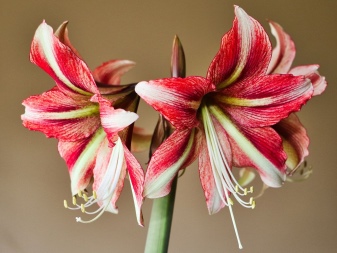
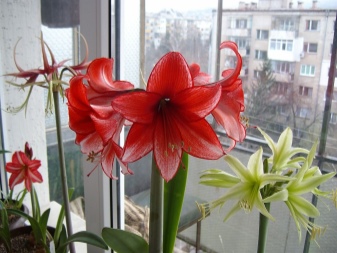
The bulbs have a characteristic pear-shaped shape, differing in grayish scales.
How to plant?
It is important to plant indoor lilies correctly, observing all the nuances and features of this process. Experts recommend buying and replanting this flower in the fall. At the bottom of the prepared pot (ceramic or plastic), it is necessary to pour stones of a fine fraction, pebbles, expanded clay, polystyrene or crushed brick.
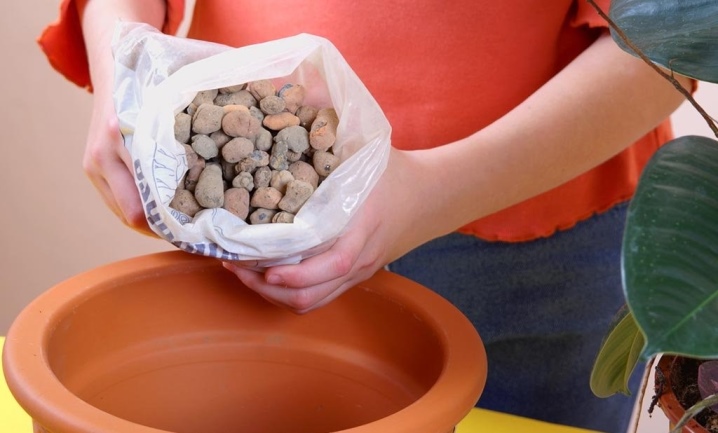
This ornamental culture, beloved by many, easily adapts to new purchased soil, so planting lilies is not as difficult as it might seem at first glance. Flowers thrive in black soil mixed with humus and leaf compost, or in soft turf.
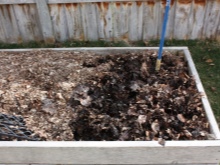
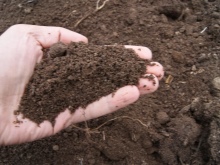

In addition, a mineral solution with potassium and nitrogen compounds is added to the pot. To get rid of all fungi, the ground must be watered with a hot solution of potassium permanganate. Then soil is poured over the drainage layer and the flower bulbs are pressed into it as carefully as possible. They need to be sprinkled with soil 15-17 cm. Next, you need to water it with warm clean liquid and move the pot to a dark place in the house.
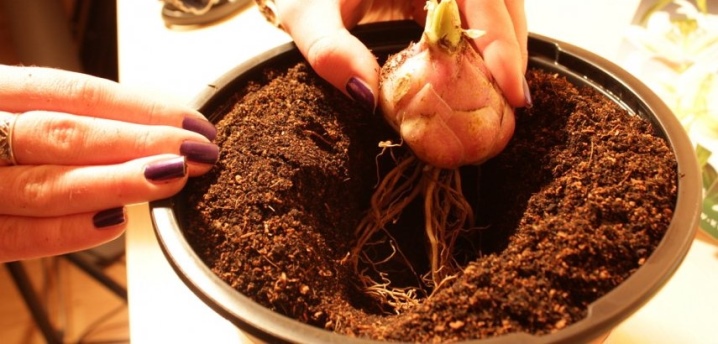
As the seedlings grow, it will be necessary to add fresh soil.
With the arrival of the warm season, the flower must be transferred to the balcony or loggia so that it gets used to the coolness. Care must be taken that the direct rays of the sun do not fall on the foliage of the plant. Excessive overheating will cause the home lily to wilt.
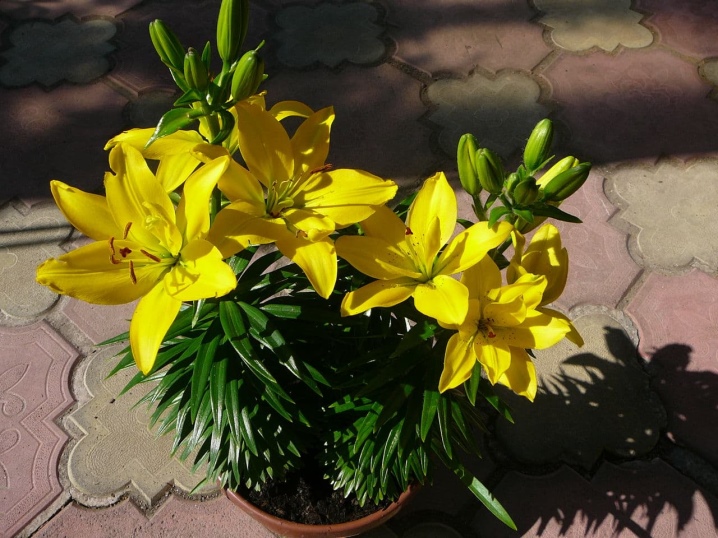
Correct care
In the course of growth and flowering lilies proper care must be provided.
- Until the buds appear the plant must be sprayed with cool water (always soft). It is allowed to care for the flower using growth stimulants, while trying not to touch the inflorescences. Next, the flowers must be shaded, otherwise burns may appear on them.
- When the plants reach 9-12 cm, they should be transferred to the balcony. Train your planting to fresh air. You should start with 20-30 minutes of walking. Increase this time gradually. If the temperature is too low, it is better not to tolerate the plants.
- If many flowers appear on the bush, you need to install the support part.
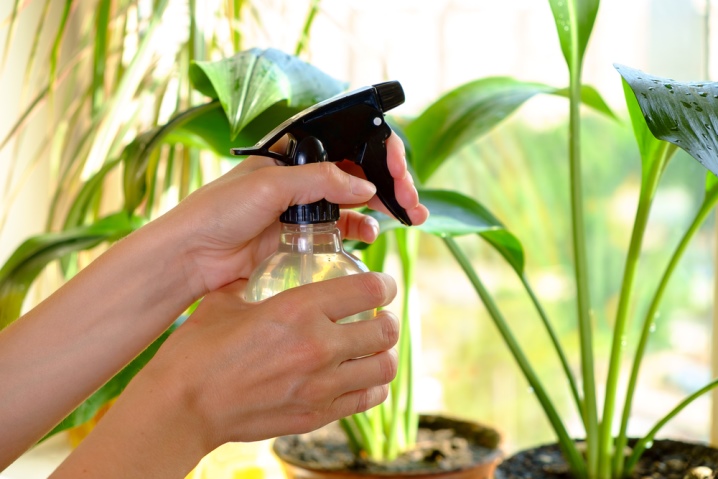
At the very beginning of growth, the flower should develop at a temperature not lower than +10 degrees. When its height is 10 cm, it is necessary to move the landing to a more illuminated place with a temperature of +16 degrees (no more). In the future, for the growth of a healthy flower, a temperature of +25 degrees and a sufficient amount of sun will be needed.
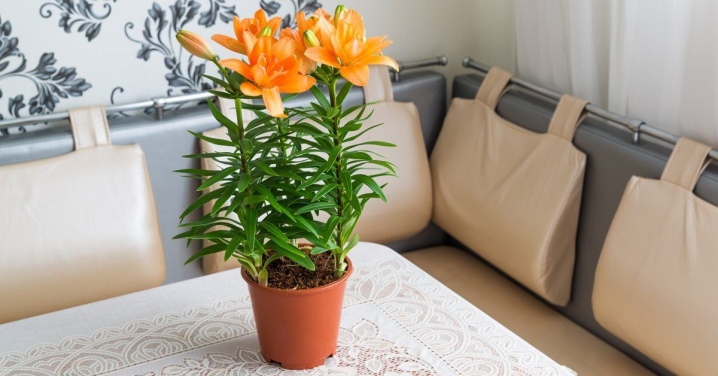
Many are interested in the question of what to do next if the lily has faded. After a lush flowering, a dormant stage begins. You do not need to cut the yellowed stems. At this time, the flower should be watered at least once a week. When the stem and foliage are completely dry, watering should be stopped.
All subspecies of lilies love high humidity. When the soil dries up, the flowers stop growing. They should be watered at least once every 3-4 days. The water should be settled rain or boiled, warm. The liquid should not be hard.
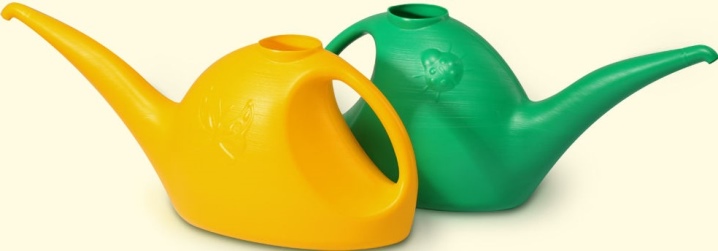
The soil must be loosened no deeper than 4-6 cm. You cannot touch the roots, otherwise you will not be able to grow a beautiful plant, even if the planting was correct. Loosening is necessary after each watering. It is worth feeding the flower with special fertilizers. This should be done after planting the bulbs, when the flower stalks are released, at the end of flowering.

Reproduction methods
Often, lilies are propagated by children - young bulbs that grow near the largest mother. They are carefully separated, and then buried 2-2.5 cm into the ground. The container with young seedlings will need to be covered with foil and aired and watered from time to time.
Lilies can be propagated and further grown by seed. This is a laborious and time-consuming process. Seeds should be bought at a specialized gardening store or collected from a box of a previously wilted flower. It is recommended to start sowing in March. The seeds should be carefully deepened into the soil by 1-1.5 cm.
After planting, it is recommended to pour river sand over the ground. Seed containers should be covered with glass or foil. As soon as the first green leaves break through, the seedlings will need to be carefully moved to a brighter place in the house. For this, a window sill above the battery is suitable. Fragile and vulnerable bulbs, when the first leaves hatch on them, will need to be dived with maximum accuracy, and then carefully transplanted into separate pots.

Lilies that were grown from seeds begin to bloom only in the second year.
Diseases and pests
Lilies, like any other indoor flowers, can get sick. The following external signs can indicate the presence of problems:
- stopping plant growth;
- lethargy;
- falling and yellowing of foliage.

If such problems occur, this means that the flower is either sick or has become a victim of insects. In this case, you should act as quickly as possible so that the lilies do not die.
If the air in the room where the lilies are kept is excessively humid and warm, dangerous fungal spores can begin to multiply on the stems and leaves of the flower. If you do not provide the plant with proper treatment and care, it will not survive. Lily will need to be carefully treated with specialized preparations against fungi.
The roots can gradually collapse from the inside, and the leaves can turn yellow and fall off if the plant suffers from a disease such as fusarium. In order not to face this serious ailment, the rhizomes must be soaked in an aqueous solution of "Fundazol" for half an hour.
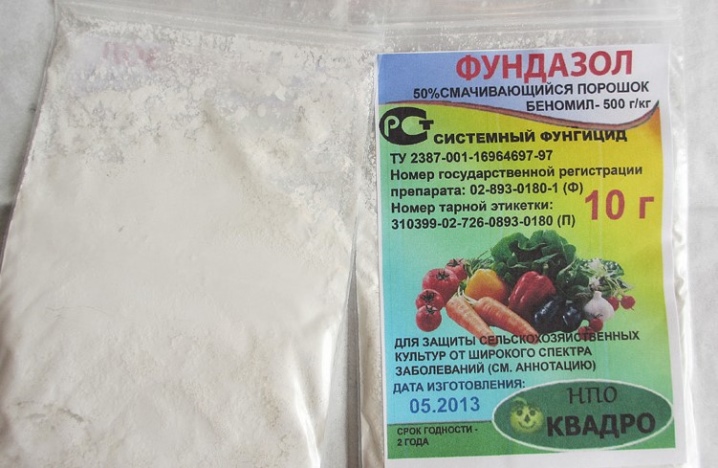
If there is stagnant water in the ground, the flower may suffer from gray or red rot. If there is not enough mineral fertilizers, the leaves will become thin, sparse and may fall off. To return the flower to its previous appearance, it must be fed from time to time.
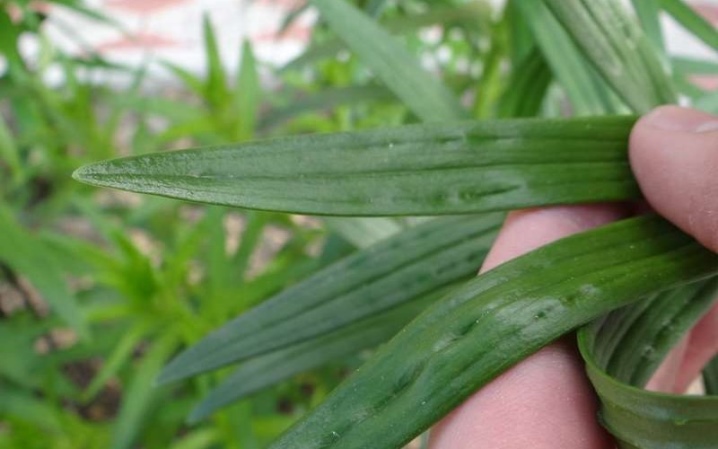
Lilies can suffer from attacks from the following dangerous parasites:
- shield;
- mealybug;
- spider mite.
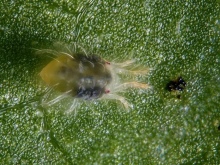

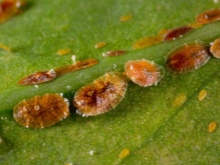
It is imperative to fight parasites in the early stages, without wasting time. If you do not start taking action to save and heal the plant in time, it will simply die. You can fight the listed pests by using special insecticides in liquid form. They are sold in many stores. These compounds require thorough watering of the soil in which the flower grows.
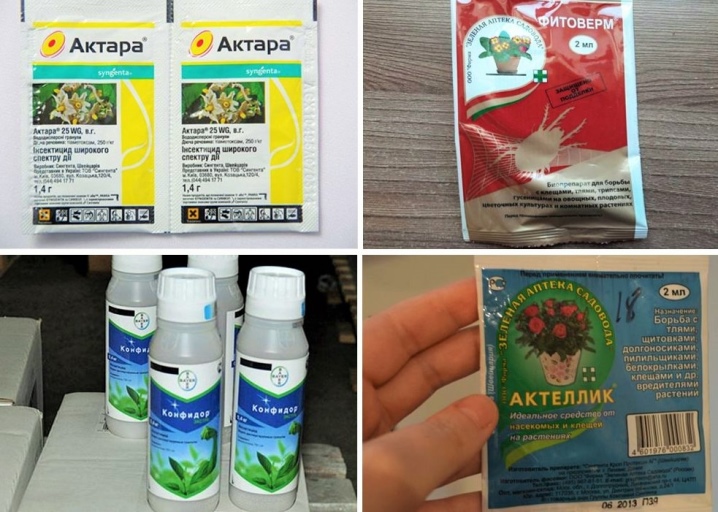
You will also need to carefully and scrupulously process the ground part of the plant.
Useful Tips
When growing and keeping home lilies you should consider a number of useful tips from experienced florists.
- If the plant is sick, it is imperative to remove all the buds from it.
- During the first year of life the ovaries of the flower must be trimmed.
- When the budding stage occurs, watering will need to be increased. But here it is important not to overdo it.
- If during the summer season a flower is taken out onto a balcony or loggia, terrace, garden area, then it is necessary to attend to the fact that during the rains, drops could not get on the lilies.
- Do not leave lilies on the balcony or loggia during the winter season. The temperature surrounded by this flower should not fall below + 15-16 degrees.
- It is advisable to regularly monitor the condition of the home flower. If there are hints of any disease or parasite attack, you should immediately take all the necessary actions to save the lilies.
- A lily in a pot can be placed not only on the windowsill, but also on the shelf next to the window. Under these conditions, there is diffused light that is ideal for these colors.
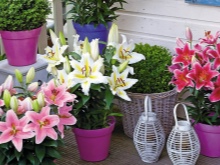
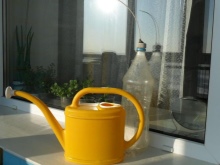
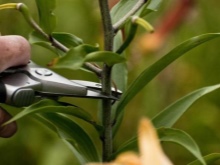
The next video will tell you about the intricacies of planting and caring for a room lily.







































































































The comment was sent successfully.